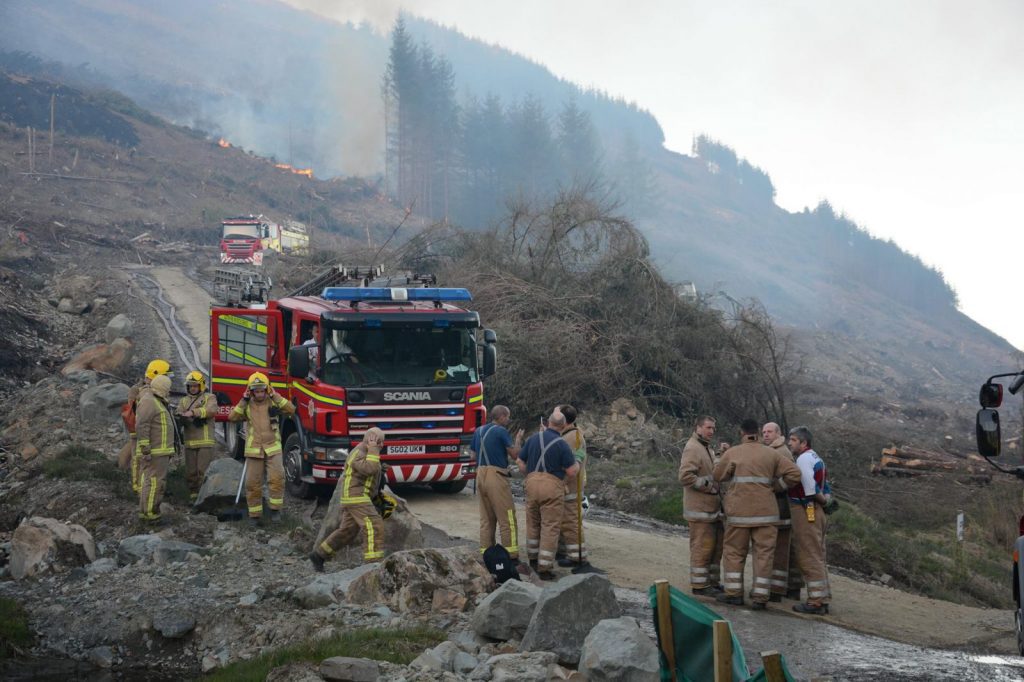THE Scottish Fire and Rescue Service is reminding the public to be aware of an increased wildfire risk across the region after a fire broke out in forestry at Glenglass, Sanquhar, Dumfries and Galloway yesterday May the 8th 2017.
Eight Scottish Fire and Rescue Service Fire Appliances were called out at 12.30pm and attended the blaze from Sanquhar, Thornhill, Dumfries, New Cumnock, Cumnock, Kilmarnock and Abington.
Dry and windy weather has already resulted in several such incidents elswhere in Scotland including Lochinver in Sutherland, and the Ochil Hills near Stirling.
Wild and grass fires can start by the careless disposal of cigarettes and barbecues or campfires left unattended.
They then have the potential to burn for days and devastate vast areas of land, wildlife and threaten the welfare of nearby communities.
And with weather forecasters predicting the current conditions to stretch into next week the public are being urged to stay safe and mindful when outdoors.
SFRS Deputy Assistant Chief Officer Andy Coueslant said: “Many rural and remote communities are hugely impacted by wildfires, which can cause significant environmental and economic damage.
“Livestock, farmland, wildlife, protected woodland and sites of special scientific interest can all be devastated by these fires – as can the lives of people living and working in rural communities.
“Human behaviour can significantly lower the chance of a wildfire starting so it’s crucial people act safely and responsibly in rural environments and follow the countryside code.”
Grass and wildfires are a common risk at this time of year when warmer weather dries out vegetation – especially dead winter foliage – which offers an ample fuel source.
Just one heat source like a campfire ember can cause it to ignite and if the wind changes direction even the smallest fire can spread uncontrollably and devastate entire hillsides.
The SFRS works closely with land managers, communities and other safety partners to prevent these incidents ever occurring.
Michael Bruce, vice chair of the Scottish Wildfire Forum, monitors the European Commission’s European Forest Fire Information System (EFFIS) – a resource that assess the risk of wildfire.
He said: “We have a high pressure weather system developing across Scotland creating these conditions at the moment.
“At the start of spring there is often a lot of dead vegetation leftover from last year – this fuel can dry out quickly with higher temperatures and lower humidity levels.”
Graham Sullivan from Scottish Natural Heritage said: “It’s great that people will be enjoying the outdoors in the good weather this weekend, but we’d urge everyone to make sure that they don’t increase the chance of wildfire – be aware of the risks and follow the Scottish Outdoor Access Code.”
Susan Davies, Director of Conservation at the Scottish Wildlife Trust added: “Wildfires are a major threat to our wildlife and wild places.
“We’d like to encourage people visiting the outdoors to be extra careful, and check the advice in the Scottish Outdoor Access Code before starting a fire.”
The public can help prevent wildfires by making sure they dispose of litter and smoking materials carefully while in rural areas.
For further advice and information about wildfires and how to prevent them visit www.firescotland.gov.uk or http://www.outdooraccess-scotland.com/
Pictures from the Glenglass Fire by Andrew Mc Dowall JNR








